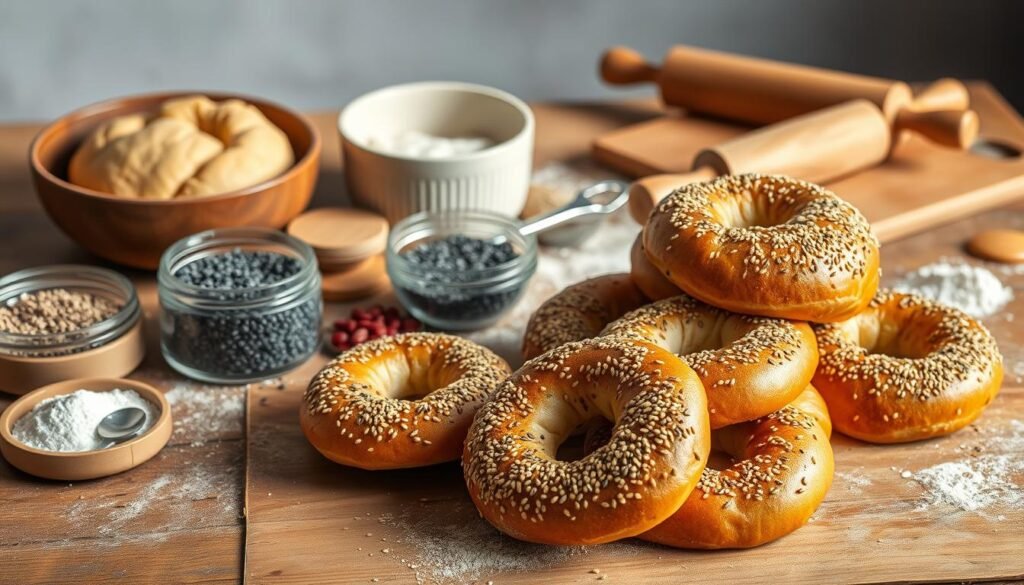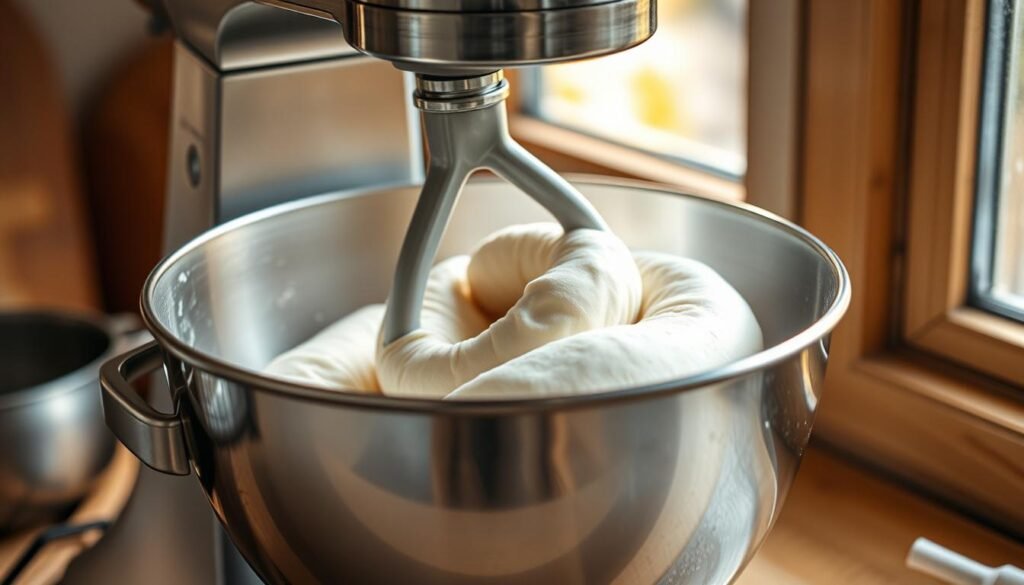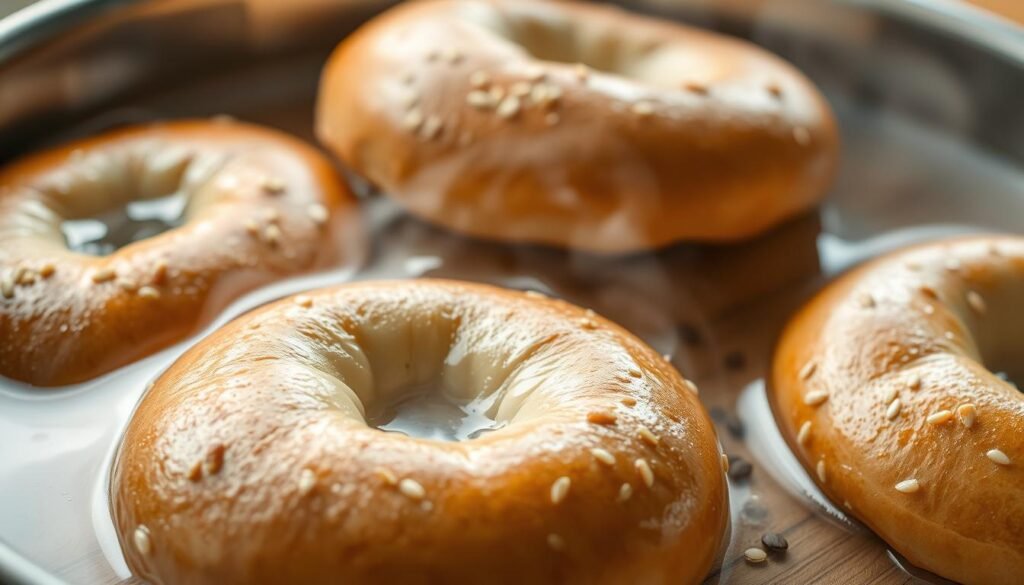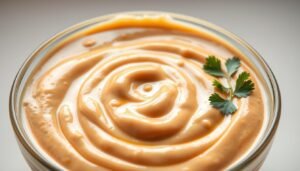Imagine starting your day with a freshly baked, chewy homemade bagel. It’s a simple pleasure that can make your breakfast or snack time better. Making bagels at home is easier than you think. With a few basic ingredients, you can create a delicious treat without preservatives or additives found in store-bought options.
Making homemade bagels is not only fun but also a great way to get the best taste and nutrition. With a straightforward homemade bagel recipe, you can enjoy your favorite bagels whenever you want.
Key Takeaways
- Easy to make with basic ingredients
- Free from preservatives and additives
- Customizable to your taste preferences
- Fun activity for the whole family
- Great way to enjoy your favorite bagels at any time
Introduction to Bagels: A Brief History
The story of bagels is one of tradition, change, and how food brings us together. As I learn about bagels’ origins and growth, I appreciate this favorite bread even more.
Origin of Bagels
Bagels started in Eastern Europe, mainly in Poland, in the 17th century. They were made by hand, boiled, and then baked in a wood-fired oven. This old way of making them has been kept alive for many years.
The Cultural Significance of Bagels
Bagels have been important in Jewish culture and traditions. They are often eaten at special events. Sharing bagels has become a big part of many cultural celebrations.
Popular Bagel Types
Many types of bagels have come into existence, each with its own taste and look. Some favorites include:
- Everything bagels, with a mix of seeds and spices on top
- Cinnamon raisin bagels, sweet and great for breakfast
- Whole wheat bagels, a healthier and nuttier choice
These different bagel types have made bagels popular worldwide.
Essential Ingredients for Homemade Bagels
The key to a great homemade bagel is in its ingredients. Each part plays a role in getting the perfect chew and taste.
Flour: The Foundation of Bagels
Flour is the heart of a bagel, giving it structure and texture. For homemade bagels, use high-protein flour like bread flour or high-protein all-purpose flour. This makes the bagel chewy inside and crusty outside.
Choosing the Right Flour: Look for flour with at least 12% protein. King Arthur Bread Flour and Bob’s Red Mill All-Purpose Flour are good choices. The right flour makes a big difference in your bagels’ texture.

Yeast: The Key to Rising
Yeast is crucial for homemade bagels. It makes the dough rise through fermentation. Active dry yeast or instant yeast works well, with instant yeast being easier to use.
Tips for Using Yeast: Keep your yeast fresh and store it right. The best temperature for yeast is between 100°F and 110°F. The right amount and temperature of yeast ensures a great rise.
| Type of Yeast | Characteristics | Usage Tips |
|---|---|---|
| Active Dry Yeast | Needs rehydration before use | Proof in warm water before adding to dough |
| Instant Yeast | Can be added directly to dry ingredients | Mix with flour and other dry ingredients |
Toppings: Customize Your Bagel
Toppings can make your homemade bagels special. You can choose from classic sesame seeds and poppy seeds to more unique options like dried garlic or onion. Try different combinations for unique tastes.
Popular Toppings: Sesame seeds, poppy seeds, dried garlic, dried onion, salt, and cinnamon sugar are favorites. Don’t be afraid to try new things and make your bagels your own.
Step-by-Step Bagel Making Process
Making homemade bagels is an art that starts with mixing the dough. First, mix 2 cups of warm water, 2 teaspoons of sugar, and 1 teaspoon of active dry yeast in a big bowl. Wait 5-10 minutes for it to get frothy.
Then, add 3 cups of all-purpose flour, 1 teaspoon of salt, and any toppings or flavorings you like. Mix until a sticky dough forms.
Mixing the Dough
To mix the dough well, use a stand mixer with a dough hook or a wooden spoon. The goal is to make the dough chewy by developing its gluten.

Kneading Techniques
Kneading is key in the bagel making process. Knead the dough for 10 minutes with a stand mixer, or 15-20 minutes by hand. This makes the dough smooth and elastic.
To knead, push down on the dough with your heel, then fold it back up. Repeat this to develop the dough’s gluten.
Shaping the Bagels
After the dough rises, it’s time to shape the bagels. Split the dough into 8-10 pieces and roll each into a ball. Make a hole in the center of each ball and stretch it into a bagel shape.
Put the shaped bagels on a baking sheet lined with parchment paper. Leave about 1 inch of space between each one. Cover them with plastic wrap or a damp towel and let them rise for 30-60 minutes, or until they double in size.
Boiling Bagels: What You Need to Know
To make authentic bagels, boiling the dough before baking is key. This step creates their unique crust and chew. We’ll look into why boiling is important and how to do it right.
Importance of Boiling
Boiling bagels before baking does several things. It creates a crust on the outside, a key feature of traditional bagels. The boiling also contributes to the chewiness by gelatinizing the starches on the surface. It also helps in making a better texture contrast between the inside and outside of the bagel.

The Right Temperature
The boiling water’s temperature is very important. It should be between 190°F and 212°F (88°C to 100°C). Boiling at the right temperature helps the bagels cook evenly and get the right crust. If the water is too hot, the bagels might cook too fast on the outside. Water that’s too cool might not give enough crust.
To wrap it up, boiling bagels is not just a step; it’s crucial for the final product. Understanding the importance of boiling and keeping the right temperature can greatly enhance your homemade bagels.
Baking Your Bagels to Perfection
Baking is where the magic happens, turning our boiled bagels into golden brown treats. To get the perfect bake, we focus on two key things: oven temperature and baking time.
Oven Temperature and Baking Time
Getting your oven to the right temperature is key. For most bagel recipes, a temperature of 425°F (220°C) is best. This temperature gives a crispy crust and a chewy inside.
Baking time depends on your bagels’ size and your oven’s performance. Usually, bagels bake in 15-20 minutes. Keep an eye on them after 15 minutes to avoid overcooking.
| Oven Temperature (°F) | Baking Time (minutes) | Result |
|---|---|---|
| 400 | 20-25 | Lightly toasted crust |
| 425 | 15-20 | Golden brown crust |
| 450 | 12-15 | Dark, crispy crust |
Recognizing When Bagels Are Done
So, how do you know when your bagels are perfectly baked? Here are a few tips:
- Check for a golden brown color. The crust should be firm and shiny.
- Tap the bottom of a bagel; it should sound hollow.
- If you have a thermometer, the internal temperature should be around 200°F (90°C).

By following these guidelines, you’ll bake delicious and visually appealing bagels. Happy baking!
Creative Bagel Flavor Variations
Bagels come in many flavors, from classic everything to sweet cinnamon raisin and savory garlic herb. You can mix different ingredients to create unique tastes that you’ll love.
Everything Bagels: A Classic Twist
Everything bagels are loved for their mix of poppy seeds, sesame seeds, garlic, salt, and sometimes onion. To make them at home, brush with egg wash and sprinkle with seasoning.
Cinnamon Raisin Bagels: A Sweet Option
Cinnamon raisin bagels are a sweet choice. Add cinnamon and raisins to your dough. Brush with cinnamon sugar for a crunchy top.
Garlic and Herb Bagels: For Savory Lovers
Garlic and herb bagels are perfect for those who prefer savory. Mix in garlic and herbs like rosemary or thyme. Brush with garlic butter for extra flavor.
Here’s a comparison of the three bagel flavors discussed:
| Bagel Flavor | Key Ingredients | Taste Profile |
|---|---|---|
| Everything Bagels | Poppy seeds, sesame seeds, dried garlic, salt, dried onion | Savory, slightly sweet |
| Cinnamon Raisin Bagels | Cinnamon, raisins, cinnamon sugar | Sweet, spicy |
| Garlic and Herb Bagels | Garlic, fresh herbs (rosemary, thyme) | Savory, aromatic |

Trying different bagel flavors is a fun way to enjoy this versatile bread. Whether you want something classic or sweet, there’s a flavor for you.
Storing and Freezing Homemade Bagels
Keeping homemade bagels fresh is key. Whether you’ve just baked them or are saving for later, knowing how to store them is important. This way, your bagels stay tasty and fresh for a while.
Best Storage Practices
To keep your bagels fresh, store them right. Here’s how:
- Cool your bagels completely on a wire rack before storing them.
- Store bagels in a paper bag or a breathable container to maintain their crustiness.
- Avoid storing bagels in airtight containers immediately, as this can make them soft.
If you’ll eat your bagels in a few days, keep them at room temperature. For longer, freezing is a good option.
How to Freeze Bagels for Later
Freezing is a great way to keep your bagels fresh longer. Here’s how to freeze them:
- Allow your bagels to cool completely.
- Place the cooled bagels in a single layer on a baking sheet and put it in the freezer until they are frozen solid.
- Transfer the frozen bagels to a freezer-safe bag or airtight container, making sure to press out as much air as possible before sealing.
- When you’re ready to eat a bagel, simply remove it from the freezer and toast or microwave it to thaw.
Freezing your bagels keeps them fresh and tasty. Just thaw and toast or bake them when you want to enjoy one.
| Storage Method | Duration | Notes |
|---|---|---|
| Room Temperature | 3-5 days | Store in a paper bag or breathable container. |
| Freezer | Up to 2 months | Freeze bagels individually before storing in a freezer-safe bag. |
By following these tips, you can enjoy your homemade bagels for a longer time. They’ll stay delicious and fresh.
Pairing Your Bagels with the Perfect Spreads
Enjoying homemade bagels is even better with the right spread. The perfect spread can make a simple bagel into a tasty treat.
Cream cheese is a classic choice for bagels. It’s a timeless favorite that never gets old.
Cream Cheese: A Traditional Choice
Cream cheese is a staple for bagel lovers. It adds a rich, tangy flavor that goes well with the chewy texture of homemade bagels. You can also flavor it with herbs and spices for more depth.
Some popular cream cheese flavors include:
- Scallion cream cheese for a savory twist
- Strawberry cream cheese for a sweet treat
- Smoked salmon cream cheese for a luxurious flavor
Other Tasty Spreads to Try
While cream cheese is a favorite, there are many other spreads to try. These include:
- Hummus for a protein-packed option
- Avocado spread for a creamy, healthy choice
- Peanut butter for a sweet and satisfying spread
Trying different spreads can help you find new favorites. Don’t be afraid to get creative and try unique pairings.
Whether you love classic cream cheese or enjoy new spreads, the most important thing is to have fun. Enjoy the process of finding your perfect bagel pairing.
Common Mistakes When Making Bagels
Exploring homemade bagels, I found some mistakes can ruin the result. Making bagels at home is fun and rewarding. But, avoiding common errors is key to success.
Knowing these mistakes helps perfect your bagel recipe. Let’s look at common errors in making bagels at home.
Over-kneading the Dough
One big mistake is over-kneading the dough. Kneading is good for gluten, but too much makes bagels tough. The right kneading time is 10 to 15 minutes, depending on the dough.
To avoid over-kneading, watch for dough signs. It should be smooth, elastic, and slightly sticky. Be careful with stand mixers to not overwork the dough.
| Kneading Method | Recommended Time | Dough Characteristics |
|---|---|---|
| Hand Kneading | 15-20 minutes | Smooth, elastic, slightly sticky |
| Stand Mixer | 10-15 minutes | Elastic, not too sticky, slightly shiny |
Incorrect Boiling Times
Boiling bagels before baking is crucial. Wrong boiling times can make bagels undercooked or too dense. Bagels should boil for 1-2 minutes on each side.
Boiling time changes with bagel size and crust thickness. The water should be between 190°F to 212°F (88°C to 100°C).
By avoiding these mistakes and adjusting your methods, you can improve your bagels. Remember, practice makes perfect. Don’t get discouraged by early failures.
Troubleshooting Your Bagel Recipe
Troubleshooting is key to making great homemade bagels. Even with a good recipe and technique, issues can still pop up. Here, I’ll cover common problems and offer solutions to fix them.
What to Do if Dough Doesn’t Rise
When your dough doesn’t rise, it’s a bummer. Several things could be the reason, like:
- Old or inactive yeast: Make sure your yeast is fresh and works well. Check its expiration date and test it in warm water with sugar to see if it foams.
- Insufficient warmth: Yeast loves warmth. Keep your dough in a warm, draft-free spot.
- Overmixing or under-mixing: Both can mess with yeast. Mix just until it comes together, then knead well.
To solve the problem, first figure out why it’s happening. Then, change your approach. For example, if your yeast is old, swap it for new yeast and try again.
How to Fix Tough Bagels
Tough bagels can come from kneading too much or baking them too long. Here’s how to make them soft:
- Avoid over-kneading: Stop kneading when the dough is smooth and elastic. Too much kneading makes them tough.
- Monitor your baking time: Bagels are done when they’re golden. Baking them too long makes them hard.
- Check your oven temperature: A too-hot oven can cook the outside too fast, leaving the inside tough.
Troubleshooting is about knowing common issues and fixing them. With time, you’ll get better at solving problems and making delicious homemade bagels.
Conclusion: Enjoying Your Homemade Bagels
Now that you’ve learned to make homemade bagels, it’s time to enjoy them. There are many ways to enjoy your freshly baked bagels. They can make any meal special.
Savoring Your Creations
Try different toppings on your homemade bagels. You can use classic cream cheese or try something new like avocado spread or hummus. Adding smoked salmon can also be a great choice. This way, every breakfast or snack becomes a new adventure.
Hosting a Bagel Brunch
Hosting a bagel brunch is a great idea. It’s a fun way to share your baking skills with friends. Set up a bagel bar with spreads, cheeses, and meats. This lets everyone make their own perfect bagel.



















